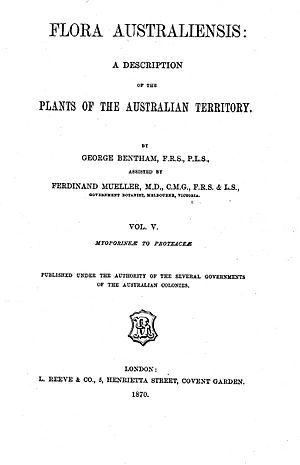Bentham's taxonomic arrangement of Dryandra facts for kids
This article is about how the famous botanist George Bentham organized a group of plants called Dryandra. These plants are now known as Banksia ser. Dryandra. Bentham published his system in 1870 in a large book called Flora Australiensis. His way of classifying these plants was used for over 100 years. It was later replaced by a new system created by Alex George in 1996.
About Dryandra Plants
The plants known as dryandras are shrubs that belong to the Proteaceae plant family. They only grow in the southwest part of Western Australia. For almost 200 years, scientists thought dryandras were their own separate group, or "genus," of plants. This was first decided in 1810 by Robert Brown.
However, in 2007, scientists moved all dryandra plants into the Banksia genus. So now, they are called Banksia ser. Dryandra. There are nearly 100 different types of these plants, including many subspecies and varieties.
Before Bentham, other botanists had tried to classify dryandras. Robert Brown made the first attempt in 1810, listing 13 species. Later, in 1830, he divided 23 species into three smaller groups called subgenera. Another botanist, Carl Meissner, published his classification in 1856. He recognized 53 species and grouped them into sections and series.
Bentham's Classification System
George Bentham's classification of Dryandra was published in 1870. It appeared in Volume V of his important work, Flora Australiensis. In his system, Bentham decided there were 47 species of Dryandra and only two varieties. He organized these plants into two main sections and then into seven smaller groups called series. He also moved a plant previously in its own genus, Hemiclidia, back into Dryandra.
Here is a simplified look at how George Bentham organized the Dryandra plants:
- Genus Dryandra (now part of Banksia ser. Dryandra)
- Section Eudryandra
- Series Armatæ (This group included plants like D. quercifolia, now known as B. heliantha)
- Series Floribundæ (This group included plants like D. floribunda, now B. sessilis var. sessilis)
- Series Concinnæ (This group included plants like D. squarrosa, now B. squarrosa)
- Series Formosæ (This group included plants like D. stupposa, now B. stuposa)
- Series Niveæ (This group included plants like D. nivea, now B. nivea)
- Series Obvallatæ (This group included plants like D. sclerophylla, now B. sclerophylla)
- Series Gymnocephalæ (This group included plants like D. Shuttleworthiana, now B. shuttleworthiana)
- Section Aphragma (This group included plants like D. tenuifolia, now B. tenuis, and D. proteoides, now B. proteoides)
- Section Eudryandra
What Happened Next
Bentham's way of classifying Dryandra was the main system used for 126 years. It was finally updated in 1996 by Alex George, who published a new arrangement. Alex George's system kept some of the groups that Bentham had created.
In 2007, two scientists, Austin Mast and Kevin Thiele, decided that Dryandra plants should be moved into the Banksia genus. They found that the Banksia group, as it was, didn't include all its related plants, so it needed to be changed. To make this change as smooth as possible, they moved Dryandra into Banksia at a "series" level. This means that none of Bentham's original sections or series for Dryandra are officially used anymore.


